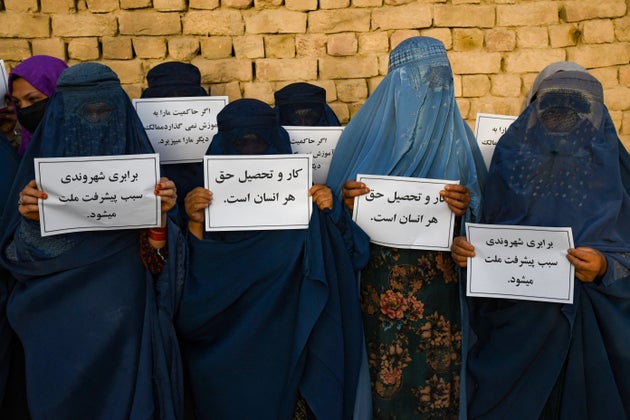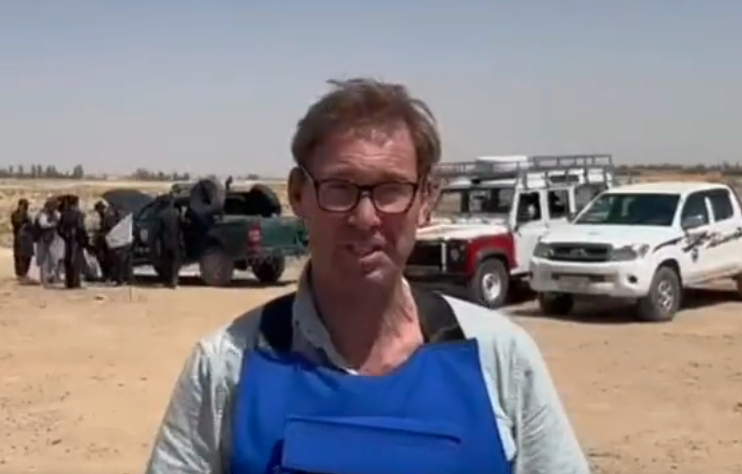 Afghan burqa-clad women hold placards as they protest for their right to education, in Mazar-i-Sharif on August 12, 2023.
Afghan burqa-clad women hold placards as they protest for their right to education, in Mazar-i-Sharif on August 12, 2023.It’s been exactly two years since the US and its allies withdrew their troops from Afghanistan – and the Taliban swept into the power vacuum.
Although there were some fleeting hopes that the militant group would be more modern than it has been in the past, over the last 24 months, it has chipped away at Afghan freedoms, particularly for women.
But, this doesn’t come without consequences – here’s what you need to know.
What has happened to women’s rights?
The Taliban has imposed more than 50 edicts, orders and restrictions over two years, according to UN Women – but here are the five most devastating.
1. Right to get an education dropped
The right to go to university has been “suspended” for women since December 2021.
2. Restriction of movement
Women have not been able to travel alone since December 2021, whether that’s boarding domestic or international flights. They have to have a male chaperone.
3. Controls over women’s appearance
In May 2022, Taliban “advised” Afghan women to wear “hijabs” in public.
Two months later, the Taliban also banned women’s beauty parlours, saying they had just one month to shut down.
4. Pushed out of work
Women have not been not allowed to work with national and international non-governmental organisations since December 2022.
In April 2023, they were banned from working with UN agencies, too.
5. Exercise restrictions
Women have not been permitted to use public baths, gyms, sports clubs and amusement parks since November 2022.
AFGHANISTAN: Today marks two years of the Taliban’s return to power in Afghanistan with unprecedented track record of human rights abuses and violations.
As of today, over 198,612 people across the world have petitioned for the Taliban to end human rights abuses and… pic.twitter.com/AOcJ8Ox2eS
— Amnesty International South Asia, Regional Office (@amnestysasia) August 15, 2023
How has this crackdown on women’s rights affected the whole of Afghanistan?
This is having a knock-on on the country as a whole, too.
6. General dissent
Between March 1 and June 27 this year, Afghan Witness recorded 95 separate women’s protests across the country, many of which were held indoors.
Many protesters face growing repression, abuse and threats – but a protest was still planned on the second anniversary of the evacuation of Kabul (August 15) in an effort to remind the international community of what is still happening there.
Women’s rights associate director at Human Rights Watch, Heather Barr, told Reuters: “The images of women protesting on the streets have been the single most important factor in compelling the international community not to look away.”
7. International aid in question
The think tank International Crisis Group said: “The unrecognised regime’s isolation undermines humanitarian and development efforts. It may result in drastic aid cuts.”
The European Parliament think tank also suggested that international donors have either already cut their humanitarian aid or are threatening to over the way women have been treated.
Afghanistan is reliant upon aid – and women could, unintentionally be most impacted by any reduction in international help.
The think tank added: “The Taliban nevertheless appears inflexible, leaving international actors with a dilemma as to how to proceed.”
8. Economy
Afghanistan was already slipping into poverty before the Taliban takeover, but their power grab accelerated that.
Afghanistan is among the countries with the lowest per capita income in the world – around 85% of the population is said to be living below the poverty line, according to the UN Development Programme.
According to UNDP modelling, if international aid declines below 30%, inflation may reach 10% in Afghanistan next year.
Surayo Buzurukova, the UNDP Deputy Resident Representative in Afghanistan told UN News that there was a clear connection between the Taliban’s treatment of women and its economic struggles.
“We calculated that it will not be possible to achieve growth and reduce poverty without women. That’s the message we try to deliver when we speak to the de facto authorities,” she said.
9. Malnutrition
Half of the population is suffering from acute poverty, and farmers’ crops are expected to struggling to feed the country – partly due to climate change (another reason the country is reliant on international aid).
Girls and women are particularly vulnerable to these struggles.
According to Global Citizen last year, Afghan girls are twice as likely to go to bed hungry as boys. They also made up 88% of child marriages as of August 2022, as families tried to reduce the number of mouths they had to feed at home.
Two-thirds of the population (28 million people) will need humanitarian assistance in 2023, according to the UN Office for Coordination of Humanitarian Affairs.
10. Standoff with the international community
The Taliban leadership is “rumoured to be planning even more draconian restrictions in the future”, according to the Crisis Group.
And the West can’t intervene without causing another war.
“Whispers among Western officials about sponsoring a civil war are dangerous and impractical. For the foreseeable future, Afghanistan’s fate will remain in the Taliban’s hands,” the group said.
Many countries, including the UK, are still wondering whether to open diplomatic relations with the Taliban in an effort to help the population as a whole.





